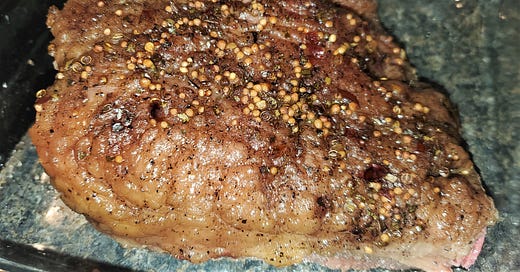I’ve been writing mostly urbanism-related material here lately, and this newsletter is overall focused on those issues and themes. But I also occasionally write on other topics, among them food, and that’s where today’s post comes down. I cook pretty much every day, and sometimes I’ll come upon a recipe or cooking method that I really like—as in this from a couple of weeks ago.
But this week I’m finally cooking up the last corned beef in my freezer, squirreled away during the St. Patrick’s Day sales when they practically give the stuff away. (It’s usually injected with a brining/tenderizing solution, so it loses a lot of its weight while cooking. But it’s still pretty darn cheap in March.) However, I’ve saved the best for last: a higher quality and slightly more natural flat-cut (the leaner portion of the brisket) corned beef, from Trader Joe’s.
Get a pot boiling? Not so fast. Over the years, as a big fan of corned beef—I stockpiled them in grad school too—I’ve played around with the cooking method. Traditionally, as you probably know, they’re boiled, along with potatoes and cabbage. This cuts down on the very high salt level (and flavors the veggies), renders out most of the fat, and, after three or four hours, results in tender meat with a characteristic chew.
However, I began to find this preparation a little bland, missing a bit of the bite of deli-sliced corned beef. In grad school, I bought a large Crock Pot and sometimes cooked corned beef on the low, eight-hour setting (turn it on before you leave for class, turn it off when you come home). I figured the reduced amount of water, and the lower and longer time and temperature, would yield more flavorful, more tender beef; I also added fresh black pepper and a couple of garlic cloves to the water, which nicely enhanced the perfunctory spice packet usually included.
The result? Crock Pot corned beef is delicious! The fat is softer, the flavor is more intense. For awhile, that was my favorite method.
But I had one more idea: roast it, as if it were a pork shoulder or something like that. I rinsed a corned beef very thoroughly for several minutes, wrapped it in foil with some water at the bottom, and roasted it for anywhere from four to six hours, somewhere around 325 Fahrenheit (depending on the exact temperature, oven placement, etc.) Then, once it’s done, pull it out of the foil, let it cool off a little, and put it on a baking sheet to finish in a much hotter oven, say 400-425, for 15 minutes or so.
This was a revelation. The rinsing, and the water in the foil-wrapping stage, cut down on the salt enough, though this preparation is definitely saltier than the others, especially compared to boiling. The meat almost entirely loses its toughness, and becomes so tender it jiggles. The fat becomes delicate and melts in your mouth, and the high-heat phase puts a little crackle on the top. Rather than turn a grayish pink, the meat stays a deep, appealing red. I don’t cook corned beef any other way now. It looks a bit like a prime rib! Before the high-heat bit, slather on some honey mustard for good measure.
And the next day? Chill it, slice it thin with a sharp knife, and you’ve got deli meat for a fraction of the price. Turkey sandwiches after Thanksgiving are a more famous use of leftovers, but next-day corned beef sandwiches are my favorite.
What about the traditionally boiled veggies? You can still do that, of course—in fact, by using some of the salty water from the foil-wrapped stage of the brisket, you can boil corned-beef-infused veggies. But I’ve begun to make the veggies without boiling as well.
The cabbage (which my wife likes more than I do) I chop up and fry on low-to-medium heat in butter or a little of the corned beef fat. The potatoes, I wrap in foil as well and roast for about an hour. If you’re going for classic baked potatoes, this is a mistake. But I’m not going for baked potatoes when I do this, which I find a little too crumbly. The combination of baking and foil-wrapping results in soft steamed potatoes with a texture almost like mashed potatoes, only they’re still whole.
This is all more time and work than throwing everything in a pot; it’s a treat, after all, and I actually enjoy it. It’s the same meal as the boiled dinner, but I find these separate preparations draw out the best of each individual ingredient.
Judging from a Google search, I’m not the only person who roasts or bakes store-bought corned beef, but I’ve also never seen it before. If you like the classic St. Patrick’s Day dinner, have you ever tried this? If not, does it sound good? Is there any classic recipe you have your own original or idiosyncratic twist on?
Related Reading:
Plant-Based Patties, Italian Peasant Style
If you like what you’re seeing, please consider a paid subscription to help support this work. You’ll get a weekend subscribers-only post, plus full access to the archive. And you’ll help ensure more material like this!





This warmed my corned-beef-loving heart! I'm going to have to try these variations. My 82 year-old grandma is still in charge of the corned beef, but I'll experiment at home without infringing on her Saint-Pat's Day traditions, haha!